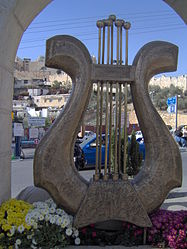User:MatthewVanitas/Kinnor
 Representation of a Kinnor David at David's City, Jerusalem | |
| Other names | Kinnor David, harp of David |
|---|---|
| Classification | String instrument |
| Related instruments | |
Kinnor (Hebrew: כִּנּוֹר) is the Hebrew name for an ancient Israelite musical instrument, the exact identification of which is unclear, but in the modern day is generally translated as "harp" or "lyre",[1]: 440 and associated with a type of lyre depicted in Israelite imagery, particular the Bar Kochba coins.[2]: 440 Modern luthiers have created reproduction lyres of the "kinnor" based on this imagery.
Identification
[edit]The kinnor is generally agreed to be a stringed instrument, and thus the stringed instrument most commonly mentioned in the Old Testament.[3]: 440 The kinnor is also the first string instrument to be mentioned in the Bible, appearing in Genesis 4:21.[4]
The Mishna states that the minimum number of kinnor to be played in the Temple is nine, with no maximum limit.[5]
The kinnor is mentioned 42 times in the Old Testament, in relation to "divine worship... prophecy... secular festivals... and prostitution."[6]
The kinnor is sometimes mentioned in conjuction with the nevel, which is also presumed to be a lyre but larger and louder than the kinnor.[7]: 43
Details
[edit]Josephus describes the kinnor as having 10 strings, made from a sheep's small intestine,[8]: 442 and played with a plectrum (pick),[9]: 441 though the Book of Samuel notes that David played the kinoor "with his hand".[10] The International Standard Bible Encyclopedia also notes that the early church fathers agreed the cithara (kinnor) had its resonator in the lower parts of its body.[11]: 442 Like the nevel, the kinnor likely consisted of a soundboard with two arms extending parallel to the body, with the arms crossed by a yoke from which the strings extend down to the body.[12]: 43
Modern instrument
[edit]History
[edit]A symbolic representation of the kinnor appears on ancient Hebrew coins.[citation needed] Jubal, the son of Lamech and Adah, is described by the first book of Moshe, Genesis 4:21 as the father of all such as handle the kinnor [harp] and ugav [pipe].[13] The identification of the instrument is uncertain, but a few historians of musical instruments say it is similar to the Ancient Greekcithara, which was in use among the Semitic peoples.[14]
The kinnor has been called the national instrument of Israel.[15] A collection of Hebrew poems entitled Kinnor Dawid was published at Wilna (Vilnius) in 1863 by David Moses Mitzkun.[16]
See also
[edit]References
[edit]- ^ http://books.google.com/books?id=Zkla5Gl_66oC&pg=PA442&dq=kinnor&hl=en&sa=X&ei=H8usUZ7VMbLF4AOnoICACw&ved=0CEgQ6AEwAw#v=onepage&q=kinnor&f=false
- ^ http://books.google.com/books?id=Zkla5Gl_66oC&pg=PA442&dq=kinnor&hl=en&sa=X&ei=H8usUZ7VMbLF4AOnoICACw&ved=0CEgQ6AEwAw#v=onepage&q=kinnor&f=false
- ^ http://books.google.com/books?id=Zkla5Gl_66oC&pg=PA442&dq=kinnor&hl=en&sa=X&ei=H8usUZ7VMbLF4AOnoICACw&ved=0CEgQ6AEwAw#v=onepage&q=kinnor&f=false
- ^ http://books.google.com/books?id=D0vq5ItRg6sC&pg=PA20&dq=kinnor&hl=en&sa=X&ei=xcusUculE9K-4AOFjIDACw&ved=0CEkQ6AEwBDgU#v=onepage&q=kinnor&f=false
- ^ http://books.google.com/books?id=sqrrPJ6Eh-cC&pg=PA8&dq=kinnor&hl=en&sa=X&ei=H8usUZ7VMbLF4AOnoICACw&ved=0CFcQ6AEwBg#v=onepage&q=kinnor&f=false
- ^ http://books.google.com/books?id=lbz3xsoATEAC&pg=PA71&dq=kinnor&hl=en&sa=X&ei=nsusUcfzJazA4AOijIGoAQ&ved=0CEoQ6AEwBDgK#v=onepage&q=kinnor&f=false
- ^ http://books.google.com/books?id=b9ST9c-7_z0C&pg=PA137&dq=kinnor&hl=en&sa=X&ei=xcusUculE9K-4AOFjIDACw&ved=0CDQQ6AEwADgU#v=onepage&q=kinnor&f=false
- ^ http://books.google.com/books?id=Zkla5Gl_66oC&pg=PA442&dq=kinnor&hl=en&sa=X&ei=H8usUZ7VMbLF4AOnoICACw&ved=0CEgQ6AEwAw#v=onepage&q=kinnor&f=false
- ^ http://books.google.com/books?id=Zkla5Gl_66oC&pg=PA442&dq=kinnor&hl=en&sa=X&ei=H8usUZ7VMbLF4AOnoICACw&ved=0CEgQ6AEwAw#v=onepage&q=kinnor&f=false
- ^ http://books.google.com/books?id=sqrrPJ6Eh-cC&pg=PA8&dq=kinnor&hl=en&sa=X&ei=H8usUZ7VMbLF4AOnoICACw&ved=0CFcQ6AEwBg#v=onepage&q=kinnor&f=false
- ^ http://books.google.com/books?id=Zkla5Gl_66oC&pg=PA442&dq=kinnor&hl=en&sa=X&ei=H8usUZ7VMbLF4AOnoICACw&ved=0CEgQ6AEwAw#v=onepage&q=kinnor&f=false
- ^ http://books.google.com/books?id=b9ST9c-7_z0C&pg=PA137&dq=kinnor&hl=en&sa=X&ei=xcusUculE9K-4AOFjIDACw&ved=0CDQQ6AEwADgU#v=onepage&q=kinnor&f=false
- ^ "JUBAL ()". 1906 Jewish Encyclopedia. JewishEncyclopedia.com. Retrieved 1 July 2012.
- ^ Chisholm, Hugh, ed. (1911). Encyclopædia Britannica (11th ed.). Cambridge University Press.
{{cite encyclopedia}}: Missing or empty|title=(help) - ^ "David's Harp". Dolmetsch Online. Retrieved December 21, 2007.
In Hebrew kinnor, also known as David's harp, is the national instrument of Israel.
- ^ "MITZKUN, DAVID MOSES". 1906 Jewish Encyclopedia. JewishEncyclopedia.com. Retrieved 1 July 2012.
External links
[edit]- The Biblical Musical Instruments. From The Music of the Bible Revealed" (Suzanne Haïk-Vantoura, 1976), edited by John Wheeler
- Bo Lawergren, “Distinctions among Canaanite, Philistine, and Israelite Lyres, and Their Global Lyrical Contexts,” Bulletin of the American Schools of Oriental Research, No. 309 (Feb., 1998), pp. 41-68.
 Texts on Wikisource:
Texts on Wikisource:
- Chisholm, Hugh, ed. (1911). Encyclopædia Britannica (11th ed.). Cambridge University Press.
{{cite encyclopedia}}: Missing or empty|title=(help) - Gilman, D. C.; Peck, H. T.; Colby, F. M., eds. (1905). New International Encyclopedia (1st ed.). New York: Dodd, Mead.
{{cite encyclopedia}}: Missing or empty|title=(help)
- Chisholm, Hugh, ed. (1911). Encyclopædia Britannica (11th ed.). Cambridge University Press.
Category:Lyres Category:Early musical instruments Category:Israeli musical instruments Category:Ancient Hebrew musical instruments
